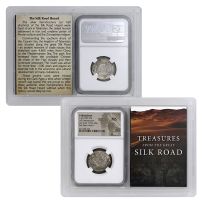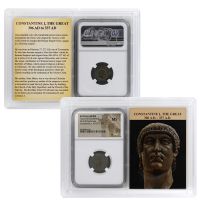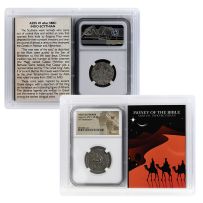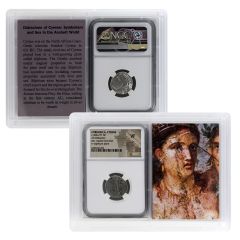Roman Empire Double Denarii (238-244 AD)
- The AR Double-Denarius is certified AU Condition by NGC
- This coin is a double-denarius is circa 238-244 AD
Silver didrachms and drachms were struck as early as 280 BC. Later types of these denominations are referred to as the quadrigatus and the victoriatus due to the designs on their reverses. The Second Punic War caused such a strain on the Roman economy that the monetary system collapsed in 215 BC. This led to the introduction of the denarius, and a related gold series which was financed by booty from the sack of Syracuse. The denarius became the main silver coin of the later republic and of the early imperial period. This mainstay of the monetary system served the Romans well for some 500 years. However, by the middle of the 3rd century AD, the denarius was debased to the point that it was actually a bronze coin. During the reign of Caracalla (in AD 214) the dew double denarius or antoninianus was added (Caracalla was a nickname derived from the cloak worn by Roman infantry, his formal name was Antoninus, after which the denomination was thought to be named). This denomination was originally a coin of high silver content, but gradually, after a period of devastating inflation, it turned into a debased shell of its former existence.
The Roman Empire of the mid to late 3rd Century was rife with political and military conflict. A parade of nearly 50 would-be emperors made a claim for the throne, most of which died within a short time. The cost of persistent war and lack of responsible leadership created vast instability in the Roman Empire.
| Quantity | 1 |
|---|---|
| Description | Silver didrachms and drachms were struck as early as 280 BC. Later types of these denominations are referred to as the quadrigatus and the victoriatus due to the designs on their reverses. The Second Punic War caused such a strain on the Roman economy that the monetary system collapsed in 215 BC. This led to the introduction of the denarius, and a related gold series which was financed by booty from the sack of Syracuse. The denarius became the main silver coin of the later republic and of the early imperial period. This mainstay of the monetary system served the Romans well for some 500 years. However, by the middle of the 3rd century AD, the denarius was debased to the point that it was actually a bronze coin. During the reign of Caracalla (in AD 214) the dew double denarius or antoninianus was added (Caracalla was a nickname derived from the cloak worn by Roman infantry, his formal name was Antoninus, after which the denomination was thought to be named). This denomination was originally a coin of high silver content, but gradually, after a period of devastating inflation, it turned into a debased shell of its former existence. The Roman Empire of the mid to late 3rd Century was rife with political and military conflict. A parade of nearly 50 would-be emperors made a claim for the throne, most of which died within a short time. The cost of persistent war and lack of responsible leadership created vast instability in the Roman Empire. |
We're confident you will be satisfied with your purchase, but if not, you may return your item for a refund or exchange within 30 days of invoice date. Shipping and handling charges are non-refundable, and the product must be returned complete and in sellable condition to qualify for a refund. Refund amount will include full purchase price and all collected taxes.Seals and cases contribute to the value of coin and currency collectibles and must remain intact and unbroken. This applies, but is not limited to: grading cases, Mint and Proof cases and packages, bag seals, original government sealed packaging, certificates of authenticity and/or any other special packaging or containers. Customers are responsible for shipping charges and risk of loss on all return shipments. All returns must be shipped by a reputable shipper and be properly packaged and fully insured. Products returned after 30 days of shipping date are subject to a 20% restocking fee.














